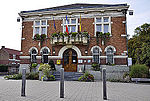Battle of Armentières

The Battle of Armentières (also Battle of Lille) was fought by German and Franco-British forces in northern France in October 1914, during reciprocal attempts by the armies to envelop the northern flank of their opponent, which has been called the Race to the Sea. Troops of the British Expeditionary Force (BEF) moved north from the Aisne front in early October and then joined in a general advance with French troops further south, pushing German cavalry and Jäger back towards Lille until 19 October. German infantry reinforcements of the 6th Army arrived in the area during October. The 6th Army began attacks from Arras north to Armentières in late October, which were faced by the BEF III Corps from Rouges Bancs, past Armentières north to the Douve river beyond the Lys. During desperate and mutually costly German attacks, the III Corps, with some British and French reinforcements, was pushed back several times, in the 6th Division area on the right flank but managed to retain Armentières. The offensive of the German 4th Army at Ypres and the Yser was made the principal German effort and the attacks of the 6th Army were reduced to probes and holding attacks at the end of October, which gradually diminished during November.
Excerpt from the Wikipedia article Battle of Armentières (License: CC BY-SA 3.0, Authors, Images).Battle of Armentières
Rue de Dunkerque, Lille
Geographical coordinates (GPS) Address Website Nearby Places Show on map
Geographical coordinates (GPS)
| Latitude | Longitude |
|---|---|
| N 50.688055555556 ° | E 2.8811111111111 ° |
Address
Bijouterie Delobel
Rue de Dunkerque 16
59280 Lille
Hauts-de-France, France
Open on Google Maps










